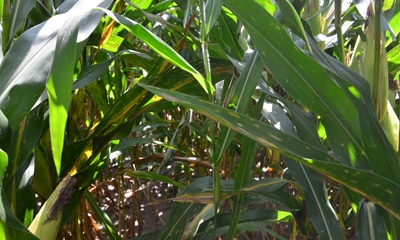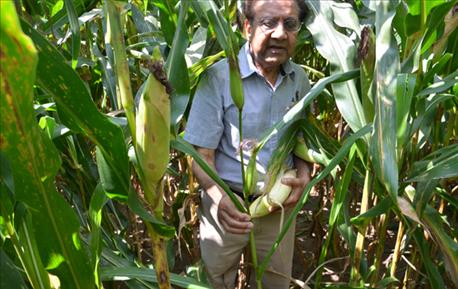
In a corn plant’s world, "the fat lady doesn’t sing," as the old saying goes, until the combine rumbles through the field. Until the very end, a corn plant does everything possible to produce and protect as many viable seeds as it can.
Dave Nanda has explained that lesson many times. He’s a retired corn breeder and consultant for Seed Consultants Inc. Walking through the Crop Watch ’16 field recently, he found a classic example of just what lengths a corn plant will go to in its effort to reproduce.
Here is a dialogue between Nanda and Indiana Prairie Farmer about the situation.
IPF: Can you explain the conditions where you found the example you want to talk about?

WILL TO SURVIVE: Note the skinny stalk in the middle of the picture. Replanted into a thin stand, this plant wound up next to a healthy plant from the first planting.
Nanda: The field was originally planted April 27, but several weeks of cold, wet weather followed. The cooperator decided to leave the original stand but spot-in more seed where the stand was thin.
IPF: Where did you find the plant in the picture?
Nanda: It was in the part of the field where the original stand was the thinnest last spring. When we visited the same spot in June, there were gaps in the original row where the newly emerged plants had no neighbors. Then there were some plants from the replant that emerged next to an original plant. I speculated that plants which emerged in the gaps would contribute yield, but late-planted ones close to earlier-planted plants would become weeds and not contribute to yield.
IPF: Is that what happened?
Nanda: Yes. Some very thin plants, obviously from the second planting, next to healthy stalks with good ears, had no ears.
IPF: What made this one plant special?

TRUE SURVIVOR: This is no TV show! Dave Nanda says this plant is holding on, hoping for pollen to make a few kernels that it thinks will become seeds.
Nanda: It was late August, but it had a very small ear shoot with silks still alive and looking for pollen. Even at that late point in the season, it was searching for pollen, hoping to make some seeds.
IPF: What is the take-home message?
Nanda: I’ve said for a long time that corn plants don’t care how much yield you get. It’s important to understand that point. They think they are making babies. They don’t know their offspring won’t be replanted. Their No. 1 goal is to reproduce — to produce as many viable seeds as possible. This particular plant, still trying to produce even a few seeds when plants around it had ears in the milk to dent stage, was a fascinating example of the corn plant’s will to reproduce!
About the Author(s)
You May Also Like




